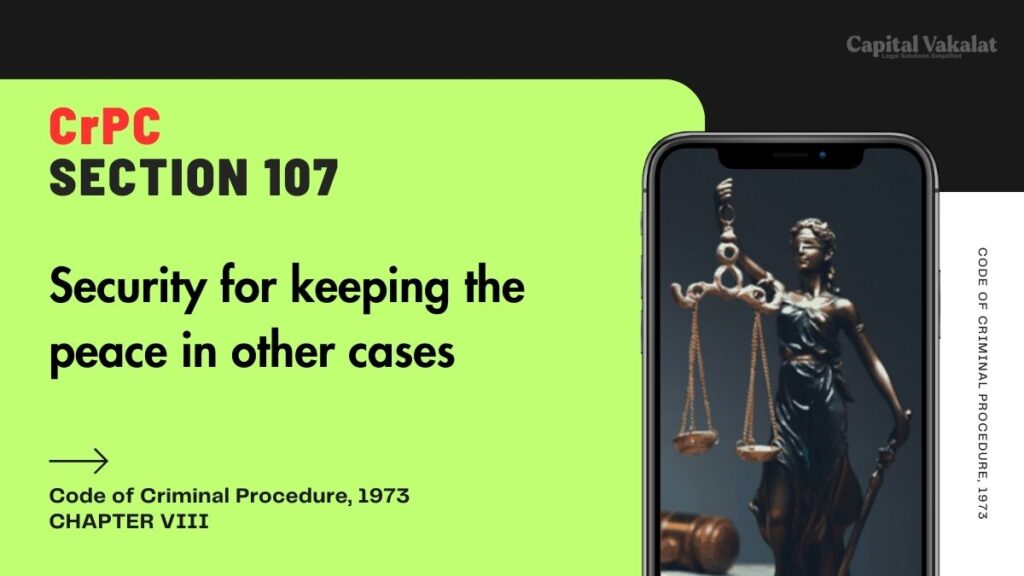Maintaining public order is paramount for any society’s progress and stability. In India, the legal framework provides various measures to ensure peace and prevent disturbances. One such provision is Section 107 of the Code of Criminal Procedure (CrPC), which empowers authorities to take preventive action.

This article delves into the intricacies of Section 107 CrPC, explaining its significance, application, and procedures to help you comprehend its vital role in maintaining societal harmony.
Bare Act. Section 107 Cr.P.C.
Security for keeping the peace in other cases.
(1) When an Executive Magistrate receives information that any person is likely to commit a breach of the peace or disturb the public tranquillity or to do any wrongful act that may probably occasion a breach of the peace or disturb the public tranquillity and is of opinion that there is sufficient ground for proceeding, he may, in the manner hereinafter provided, require such person to show cause why he should not be ordered to execute a bond 1 [with or without sureties,] for keeping the peace for such period, not exceeding one year, as the Magistrate thinks fit.
(2) Proceedings under this section may be taken before any Executive Magistrate when either the place where the breach of the peace or disturbance is apprehended is within his local jurisdiction or there is within such jurisdiction a person who is likely to commit a breach of the peace or disturb the public tranquillity or to do any wrongful act as aforesaid beyond such jurisdiction.
1. Ins. by Act 45 of 1978, s. 11 (w.e.f. 18-12-1978).
Section 107 CrPC: An Overview
Section 107 of the CrPC is a preventive measure aimed at curbing potential threats to peace and tranquility. It empowers an Executive Magistrate to require a person to show cause why they should not be ordered to execute a bond for keeping the peace for up to one year. This section is crucial in preempting disturbances and ensuring that individuals likely to cause trouble are kept in check.
Historical Context and Evolution
The roots of preventive measures like Section 107 can be traced back to British colonial rule in India. The need for such provisions arose from the desire to maintain public order and prevent uprisings. Over the years, this section has evolved to address contemporary challenges, balancing individual rights with societal needs.
When Can Section 107 CrPC Be Invoked?
Section 107 CrPC can be invoked when an Executive Magistrate receives information that any person is likely to commit a breach of the peace or disturb public tranquility. This information can come from various sources, including police reports, complaints from the public, or any other credible source. The Magistrate then issues a notice to the person, requiring them to appear and show cause why they should not be bound over for maintaining peace.
Procedural Aspects of Section 107 CrPC
The procedure under Section 107 involves several steps:
1. Receipt of Information: The Executive Magistrate must receive credible information about a potential breach of peace.
2. Issuance of Notice: The Magistrate issues a notice to the concerned individual, specifying the nature of the threat and requiring their appearance.
3. Inquiry: Upon the individual’s appearance, the Magistrate conducts an inquiry to assess the validity of the threat.
4. Bond Execution: If satisfied that the individual poses a threat, the Magistrate orders the execution of a bond, with or without sureties, for a specified period.
Legal Safeguards and Rights
While Section 107 CrPC aims to maintain peace, it also includes safeguards to protect individual rights. The person has the right to be heard and to present evidence. Moreover, the requirement of a bond and the inquiry process ensure that the measure is not applied arbitrarily.
Challenges and Criticisms
Despite its importance, Section 107 CrPC has faced criticism. Critics argue that it can be misused for harassment or to curb dissent. Ensuring that the provision is applied judiciously and not as a tool for oppression is a challenge that the legal system must continually address.
Significance in Contemporary Society
In today’s context, where societal tensions can arise from various factors, Section 107 CrPC remains a vital tool for maintaining order. It acts as a deterrent for those who might disrupt peace, providing a legal framework to address potential threats preemptively.
Case Studies and Judicial Interpretations
Several judicial interpretations have clarified the scope and application of Section 107 CrPC. For instance, courts have emphasized the need for concrete evidence before invoking this section, ensuring that it is not used indiscriminately.
Conclusion
Section 107 CrPC: Security for keeping the peace in other cases, remains a critical component of India’s legal framework. By providing a mechanism to prevent disturbances and maintain public tranquility, it upholds the delicate balance between individual freedoms and societal stability. As we navigate the complexities of modern society, understanding and applying such provisions judiciously is essential for fostering a peaceful and harmonious community.
Frequently Asked Questions
When can Section 107 CrPC be invoked?
It can be invoked when there is credible information that a person is likely to commit a breach of the peace or disturb public tranquility.
What are the procedural steps under Section 107 CrPC?
The steps include the receipt of information, issuance of a notice, conducting an inquiry, and, if necessary, ordering the execution of a bond.
What safeguards exist to protect individual rights under Section 107 CrPC?
The individual has the right to be heard, present evidence, and the Magistrate must conduct a thorough inquiry before ordering a bond.
What are the criticisms of Section 107 CrPC?
Critics argue that it can be misused for harassment or to curb dissent, highlighting the need for judicious application.
How is Section 107 CrPC significant today?
It is crucial for preemptively addressing potential threats to peace, acting as a deterrent for those who might disrupt public order.